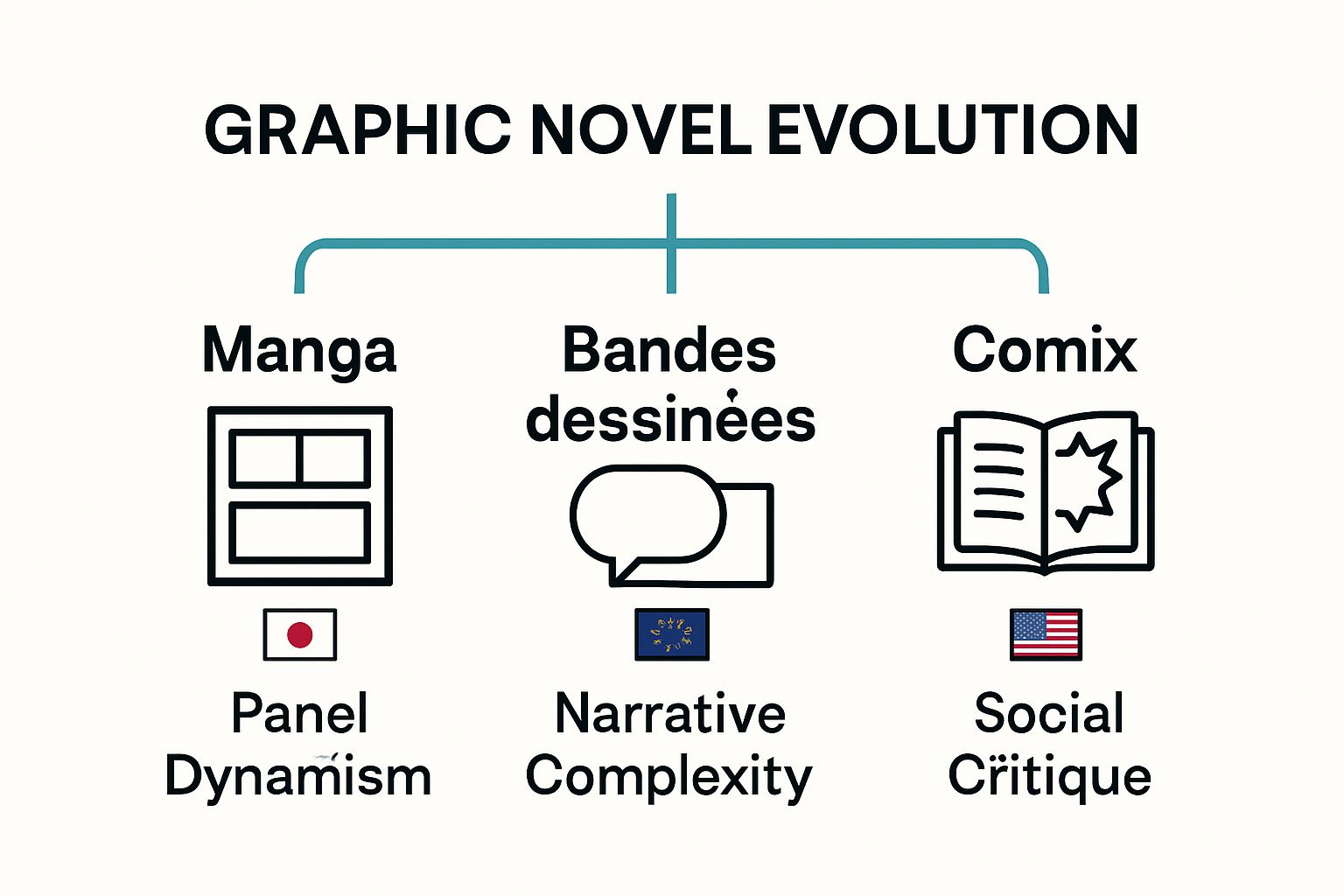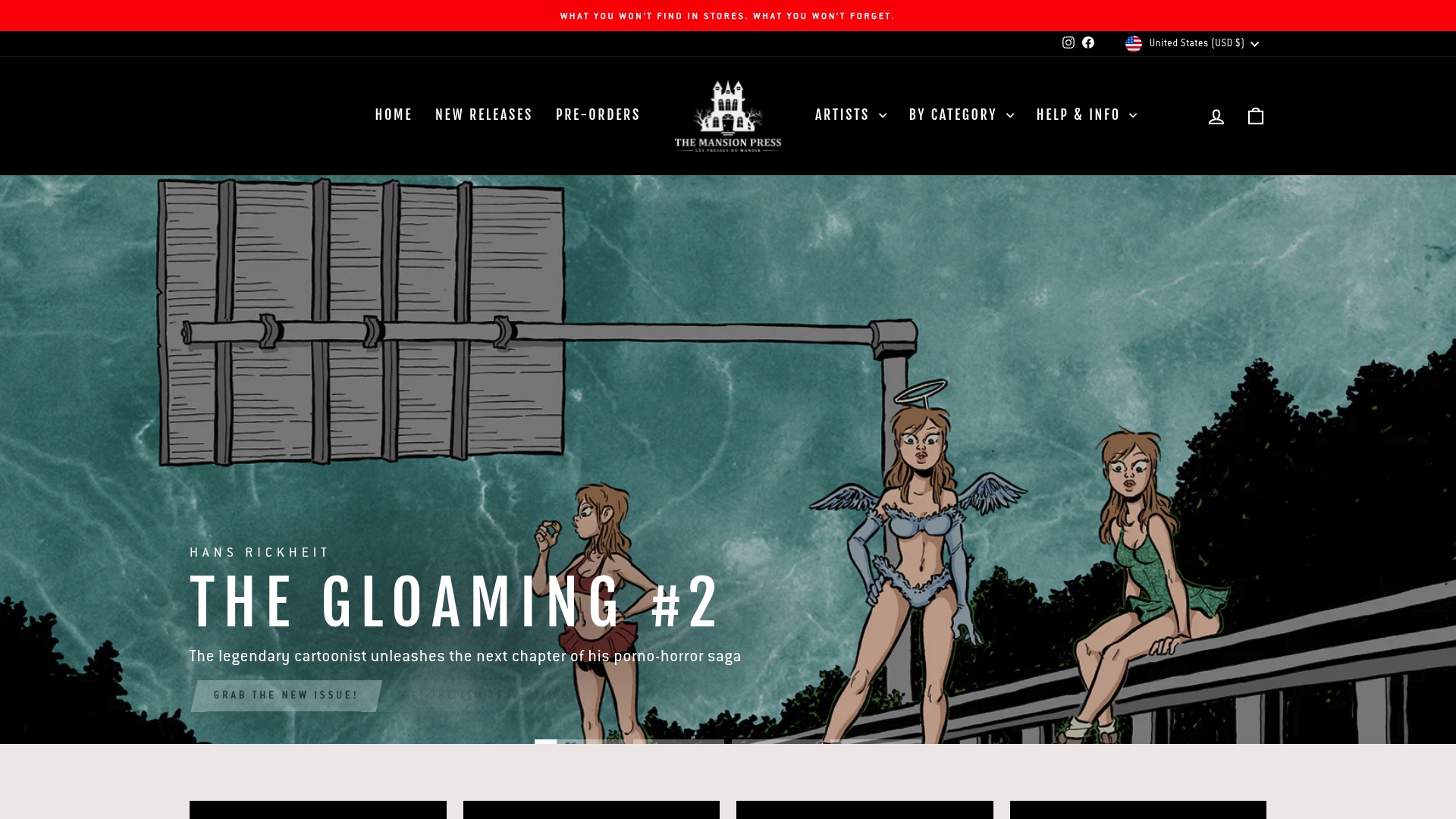Understanding the Evolution of Graphic Novel Art
Graphic novel art is redefining how stories are told, blending visuals and words into unforgettable experiences. Some panels pack more emotional impact than an entire movie scene or chapter of a novel. Most people expect bold colors and superheroes, but the real signature of graphic novels is their deep narrative complexity and rich psychological themes. This is where the art form breaks all the old rules and shows just how powerful illustrated storytelling can be.
Table of Contents
- What Defines Graphic Novel Art?
- The Historical Context of Graphic Novels
- Key Influences on Graphic Novel Art Styles
- The Role of Technology in Evolution
- Understanding Themes and Narratives in Graphic Novels
Quick Summary
| Takeaway | Explanation |
|---|---|
| Graphic novels blend art and storytelling. | They use visual elements to create immersive narratives that convey emotions and themes effectively. |
| Innovative panel designs enhance narrative flow. | Unique layouts allow for complex storytelling techniques, breaking traditional formatting to better engage readers. |
| Diverse cultural influences shape graphic novels. | Various artistic traditions, from Japanese manga to European comics, have contributed to graphic novel styles and narratives. |
| Technology transforms creation and distribution. | Digital tools and online platforms enable more artists to share their work globally and reach wider audiences. |
| Themes in graphic novels tackle social issues. | They explore deep themes like identity, social critique, and history, adding depth to the visual medium. |
What Defines Graphic Novel Art?
Graphic novel art represents a sophisticated visual storytelling medium that transcends traditional narrative boundaries. Unlike conventional comic books or illustrated texts, graphic novels integrate complex visual and textual elements to create immersive storytelling experiences. Defining the artistic nuances of graphic novels requires understanding its unique compositional characteristics.
Visual Narrative Complexity
Graphic novel art distinguishes itself through multifaceted visual storytelling techniques. Artists carefully construct narrative sequences using intricate panel designs, expressive character illustrations, and strategic visual composition. These visual elements communicate emotions, plot progression, and thematic undertones far beyond simple text descriptions. Each panel becomes a miniature canvas representing narrative fragments that collectively build a cohesive story.
Structural and Stylistic Elements
The evolution of graphic novel art encompasses several critical structural components:
- Panel Design: Innovative layouts that break traditional rectangular boundaries
- Color Palette: Deliberate color choices reflecting mood and narrative tone
- Character Rendering: Sophisticated character illustrations communicating psychological depth
These elements work synergistically to transform graphic novels from simple illustrated stories into complex artistic expressions. Read more about graphic novel formats to explore deeper nuances of this captivating art form.
Graphic novel art continues to challenge traditional storytelling boundaries, offering audiences immersive experiences that blend visual aesthetics with narrative complexity. By merging artistic innovation with storytelling techniques, graphic novels have established themselves as a unique and respected artistic medium.
The Historical Context of Graphic Novels
Graphic novels emerged as a distinctive artistic medium through a complex evolution spanning multiple cultural and artistic movements. Their origins can be traced to early 20th century visual storytelling techniques, where artists began challenging traditional narrative representations. Historical research from the American Library Association reveals that graphic novels developed as a nuanced intersection between sequential art, literary narrative, and visual communication.
Pioneering Cultural Movements
The roots of graphic novel art can be found in diverse artistic traditions. European woodcut narratives, Japanese manga, and American underground comix all contributed significant foundations to this emerging medium. Artists like Will Eisner and Art Spiegelman pioneered narrative techniques that transformed comics from simple entertainment into sophisticated storytelling platforms.
 Spiegelman’s “Maus,” which won a Pulitzer Prize, exemplified graphic novels’ potential to address complex historical narratives through visual storytelling.
Spiegelman’s “Maus,” which won a Pulitzer Prize, exemplified graphic novels’ potential to address complex historical narratives through visual storytelling.
Technological and Cultural Transformations
Several key developments propelled graphic novels into mainstream artistic recognition:
- Print Technology Advances: Improved color printing and paper quality
- Cultural Legitimacy: Academic and literary recognition of graphic narratives
- Diverse Storytelling Perspectives: Increased representation of marginalized voices
These transformative elements enabled graphic novels to transcend their initial perception as juvenile entertainment. Learn more about the evolution of graphic novels to understand their remarkable journey.
The historical progression of graphic novels represents a testament to artistic innovation. From underground counterculture movements to respected literary form, graphic novels have consistently challenged conventional storytelling boundaries, offering audiences unprecedented narrative experiences that blend visual artistry with profound storytelling depth.

Key Influences on Graphic Novel Art Styles
Graphic novel art styles have been profoundly shaped by diverse cultural, artistic, and technological influences that transcend traditional visual storytelling boundaries. Early artistic movements demonstrate how graphic novels evolved through complex interactions between visual representation and narrative innovation.
International Artistic Traditions
Different cultural traditions significantly contributed to graphic novel art style development. Japanese manga introduced dynamic panel layouts and emotional expressiveness, while European bandes dessinées emphasized sophisticated narrative complexity. North American underground comix pioneered more experimental and socially critical visual storytelling techniques. These international artistic traditions created a rich, multifaceted visual language that expanded graphic novel artistic possibilities.
Technological and Aesthetic Innovations
Several transformative elements dramatically influenced graphic novel art styles:
- Printing Technologies: Advanced color reproduction techniques
- Digital Design Tools: Computer graphics and digital illustration software
- Global Cultural Exchange: Increased cross-cultural artistic interactions
These technological advancements enabled artists to experiment with unprecedented visual complexity and storytelling approaches. Explore the fascinating world of comic art styles to understand the intricate evolution of these visual narratives.
The continuous interplay between artistic innovation, cultural perspectives, and technological capabilities ensures that graphic novel art styles remain dynamic and responsive to changing creative landscapes. Artists consistently push boundaries, transforming visual storytelling into a powerful medium for expressing complex human experiences and perspectives.
To clarify how various international and technological influences have shaped graphic novel styles, the following table summarizes key contributions by region and innovation.
| Influence | Description | Example Contribution |
|---|---|---|
| Japanese Manga | Introduced dynamic panel layouts and emotional visual expressiveness | Emphasized movement, emotion |
| European Bandes Dessinées | Brought sophisticated narrative complexity and refined visual storytelling | Complex plots, artistic style |
| North American Underground Comix | Pioneered experimental and socially critical storytelling approaches | Edgy themes, counterculture |
| Printing Technologies | Enabled advanced color reproduction and better material quality | Richer visuals, fine detail |
| Digital Design Tools | Provided precision and editing freedom through computer graphics and illustration software | Intricate art, innovation |
| Global Cultural Exchange | Increased cross-cultural inspiration and stylistic blending among graphic novel artists | Diverse hybrid genres |
The Role of Technology in Evolution
Technology has fundamentally transformed graphic novel art, reshaping creative processes, distribution mechanisms, and audience engagement. Digital innovations from the Smithsonian Magazine demonstrate how technological advancements have revolutionized visual storytelling mediums.
Digital Creation and Design
Digital technologies have dramatically expanded artists’ creative capabilities. Advanced graphic design software enables unprecedented precision in illustration, allowing artists to create intricate details, manipulate color palettes, and experiment with complex visual narratives. Vector graphics and digital drawing tools provide artists with infinite editing possibilities that traditional media could never offer. These technological innovations mean graphic novel creators can now produce more sophisticated and nuanced visual experiences.
Distribution and Accessibility
Technological evolution has fundamentally altered how graphic novels are produced and consumed:
- Online Platforms: Web-based comic distribution channels
- Digital Publishing: Instant global accessibility
- Interactive Formats: Multimedia storytelling experiences
These technological shifts have democratized graphic novel creation, enabling independent artists to reach global audiences without traditional publishing constraints. Explore emerging graphic novel technologies to understand the cutting edge of visual storytelling.
The symbiotic relationship between technological innovation and artistic expression continues to push graphic novel art into exciting, uncharted territories. As digital tools become more sophisticated, artists gain increasingly powerful means to translate complex narratives and emotional landscapes into visually compelling experiences.
Understanding Themes and Narratives in Graphic Novels
Graphic novels represent a sophisticated storytelling medium where visual imagery and narrative complexity intersect to create profound artistic experiences. Academic research from literary studies reveals that graphic novels transcend traditional storytelling by integrating visual metaphors, symbolic representations, and multilayered narrative structures.
Narrative Complexity and Storytelling Techniques
Graphic novels employ unique narrative techniques that distinguish them from traditional literature. Artists strategically use panel composition, visual perspective, and graphic design to communicate emotional landscapes and complex storylines. Unlike linear text narratives, graphic novels allow simultaneous storytelling through visual and textual elements, enabling readers to interpret narrative depth through intricate visual cues and symbolic representations.
Thematic Exploration and Social Commentary
Graphic novels have emerged as powerful platforms for exploring complex social themes and personal experiences:
- Personal Identity: Exploring individual psychological landscapes
- Social Critique: Addressing systemic societal challenges
- Historical Representation: Reinterpreting historical narratives through visual storytelling
These narrative approaches transform graphic novels from entertainment mediums into profound artistic statements. Discover more about narrative techniques in graphic novels to understand the depth of this artistic form.
The evolution of graphic novel narratives represents a continuous dialogue between artistic innovation, cultural perspectives, and storytelling possibilities. By challenging conventional narrative structures, graphic novels offer audiences immersive experiences that transcend traditional literary boundaries, inviting deeper engagement with complex human experiences.
The following table breaks down critical narrative and thematic elements commonly explored within graphic novels, helping to distinguish their depth and complexity compared to traditional stories.
| Theme or Technique | Focus/Function | Example from Article |
|---|---|---|
| Narrative Complexity | Uses layered panels, visual metaphors, and simultaneous storytelling | Panel composition, visual cues |
| Personal Identity | Explores psychological landscapes and self-discovery | Individual experiences |
| Social Critique | Addresses societal issues and systemic challenges | Marginalized voices, critique |
| Historical Representation | Presents or reinterprets historical events through visual means | Works like “Maus” |
| Visual Storytelling | Blends art with narrative for immersive reader experiences | Emotional and thematic impact |
| Symbolism | Integrates visual symbols for deeper narrative meaning | Visual metaphors, context |
Discover the Next Step in Graphic Novel Art Evolution
Are you fascinated by how graphic novels have pushed the boundaries of art and storytelling, as explored in our article on the evolution of graphic novel art? Many readers struggle to access the unique, limited-edition works and original pieces that reflect the complexity and history discussed. Collecting and experiencing these groundbreaking visuals can be difficult, especially when searching beyond mainstream releases. At The Mansion Press, you can bridge the gap between artistic exploration and personal ownership.

Browse our curated selection of rare artbooks, collector’s editions, and original artworks from rising independent creators and iconic graphic novel artists. Each item brings the innovation, narrative depth, and exclusive artistry described in the article straight into your hands. Do not miss out on the chance to own pieces that reflect genuine creative evolution. Start your journey today by exploring The Mansion Press Collection. Looking for insights into avant-garde comic art styles or seeking to understand the many formats of graphic novels? Find your inspiration here and transform your collection now.
Frequently Asked Questions
What differentiates graphic novels from traditional comic books?
Graphic novels incorporate complex narrative structures and sophisticated artistic techniques, blending visual storytelling with deep thematic exploration, unlike traditional comic books which may prioritize quick entertainment.
How has technology influenced graphic novel art?
Technological advancements, such as digital design tools and online distribution platforms, have expanded creative possibilities for artists and made graphic novels more accessible to a global audience.
What are some key themes commonly explored in graphic novels?
Graphic novels often delve into themes like personal identity, social critique, and historical representation, offering profound commentary on complex human experiences through visual narrative.
Who are some pioneering artists in the graphic novel genre?
Notable pioneers such as Will Eisner and Art Spiegelman have greatly influenced graphic novel art, using innovative storytelling techniques and complex narratives, with works like “Maus” exemplifying the medium’s potential.

